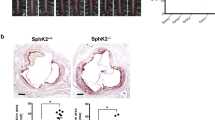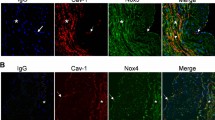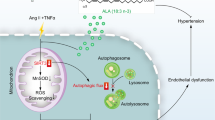Abstract
Endothelial dysfunction is a critical factor in many cardiovascular diseases, including hypertension. Although lipid signaling has been implicated in endothelial dysfunction and cardiovascular disease, specific molecular mechanisms are poorly understood. Here we report that Nogo-B, a membrane protein of the endoplasmic reticulum, regulates endothelial sphingolipid biosynthesis with direct effects on vascular function and blood pressure. Nogo-B inhibits serine palmitoyltransferase, the rate-limiting enzyme of the de novo sphingolipid biosynthetic pathway, thereby controlling production of endothelial sphingosine 1-phosphate and autocrine, G protein–coupled receptor–dependent signaling by this metabolite. Mice lacking Nogo-B either systemically or specifically in endothelial cells are hypotensive, resistant to angiotensin II–induced hypertension and have preserved endothelial function and nitric oxide release. In mice that lack Nogo-B, pharmacological inhibition of serine palmitoyltransferase with myriocin reinstates endothelial dysfunction and angiotensin II–induced hypertension. Our study identifies Nogo-B as a key inhibitor of local sphingolipid synthesis and shows that autocrine sphingolipid signaling within the endothelium is critical for vascular function and blood pressure homeostasis.
This is a preview of subscription content, access via your institution
Access options
Subscribe to this journal
Receive 12 print issues and online access
$209.00 per year
only $17.42 per issue
Buy this article
- Purchase on Springer Link
- Instant access to full article PDF
Prices may be subject to local taxes which are calculated during checkout






Similar content being viewed by others
Accession codes
References
Kearney, P.M. et al. Global burden of hypertension: analysis of worldwide data. Lancet 365, 217–223 (2005).
Vanhoutte, P.M. Endothelial dysfunction in hypertension. J. Hypertens. Suppl. 14, S83–S93 (1996).
Taddei, S. & Salvetti, A. Pathogenetic factors in hypertension. Endothelial factors. Clin. Exp. Hypertens. 18, 323–335 (1996).
Taddei, S. et al. Defective L-arginine-nitric oxide pathway in offspring of essential hypertensive patients. Circulation 94, 1298–1303 (1996).
Huang, P.L. et al. Hypertension in mice lacking the gene for endothelial nitric oxide synthase. Nature 377, 239–242 (1995).
Haynes, W.G., Noon, J.P., Walker, B.R. & Webb, D.J. L-NMMA increases blood pressure in man. Lancet 342, 931–932 (1993).
Aisaka, K., Gross, S.S., Griffith, O.W. & Levi, R. NG-methylarginine, an inhibitor of endothelium-derived nitric oxide synthesis, is a potent pressor agent in the guinea pig: does nitric oxide regulate blood pressure in vivo? Biochem. Biophys. Res. Commun. 160, 881–886 (1989).
Dantas, A.P., Igarashi, J. & Michel, T. Sphingosine 1-phosphate and control of vascular tone. Am. J. Physiol. Heart Circ. Physiol. 284, H2045–H2052 (2003).
Igarashi, J. & Michel, T. S1P and eNOS regulation. Biochim. Biophys. Acta 1781, 489–495 (2008).
Salomone, S. et al. S1P3 receptors mediate the potent constriction of cerebral arteries by sphingosine-1-phosphate. Eur. J. Pharmacol. 469, 125–134 (2003).
Coussin, F., Scott, R.H., Wise, A. & Nixon, G.F. Comparison of sphingosine 1-phosphate-induced intracellular signaling pathways in vascular smooth muscles: differential role in vasoconstriction. Circ. Res. 91, 151–157 (2002).
Venkataraman, K. et al. Vascular endothelium as a contributor of plasma sphingosine 1-phosphate. Circ. Res. 102, 669–676 (2008).
Hänel, P., Andreani, P. & Graler, M.H. Erythrocytes store and release sphingosine 1-phosphate in blood. FASEB J. 21, 1202–1209 (2007).
Camerer, E. et al. Sphingosine-1-phosphate in the plasma compartment regulates basal and inflammation-induced vascular leak in mice. J. Clin. Invest. 119, 1871–1879 (2009).
Young, R.M. et al. Zebrafish yolk-specific not really started (nrs) gene is a vertebrate homolog of the Drosophila spinster gene and is essential for embryogenesis. Dev. Dyn. 223, 298–305 (2002).
Tauseef, M. et al. Activation of sphingosine kinase-1 reverses the increase in lung vascular permeability through sphingosine-1-phosphate receptor signaling in endothelial cells. Circ. Res. 103, 1164–1172 (2008).
Jung, B. et al. Flow-regulated endothelial S1P receptor-1 signaling sustains vascular development. Dev. Cell 23, 600–610 (2012).
Nagiec, M.M., Baltisberger, J.A., Wells, G.B., Lester, R.L. & Dickson, R.C. The LCB2 gene of Saccharomyces and the related LCB1 gene encode subunits of serine palmitoyltransferase, the initial enzyme in sphingolipid synthesis. Proc. Natl. Acad. Sci. USA 91, 7899–7902 (1994).
Hanada, K. et al. Sphingolipids are essential for the growth of Chinese hamster ovary cells. Restoration of the growth of a mutant defective in sphingoid base biosynthesis by exogenous sphingolipids. J. Biol. Chem. 267, 23527–23533 (1992).
Breslow, D.K. et al. Orm family proteins mediate sphingolipid homeostasis. Nature 463, 1048–1053 (2010).
Han, S., Lone, M.A., Schneiter, R. & Chang, A. Orm1 and Orm2 are conserved endoplasmic reticulum membrane proteins regulating lipid homeostasis and protein quality control. Proc. Natl. Acad. Sci. USA 107, 5851–5856 (2010).
Moffatt, M.F. et al. Genetic variants regulating ORMDL3 expression contribute to the risk of childhood asthma. Nature 448, 470–473 (2007).
Kim, J.E., Li, S., GrandPre, T., Qiu, D. & Strittmatter, S.M. Axon regeneration in young adult mice lacking Nogo-A/B. Neuron 38, 187–199 (2003).
Zheng, B. et al. Lack of enhanced spinal regeneration in Nogo-deficient mice. Neuron 38, 213–224 (2003).
Acevedo, L. et al. A new role for Nogo as a regulator of vascular remodeling. Nat. Med. 10, 382–388 (2004).
Beverelli, F., Bea, M.L., Puybasset, L., Giudicelli, J.F. & Berdeaux, A. Chronic inhibition of NO synthase enhances the production of prostacyclin in coronary arteries through upregulation of the cyclooxygenase type 1 isoform. Fundam. Clin. Pharmacol. 11, 252–259 (1997).
Davies, P.F. Flow-mediated endothelial mechanotransduction. Physiol. Rev. 75, 519–560 (1995).
Bevan, J.A. & Henrion, D. Pharmacological implications of the flow-dependence of vascular smooth muscle tone. Annu. Rev. Pharmacol. Toxicol. 34, 173–190 (1994).
Jozsef, L. et al. Reticulon 4 is necessary for endoplasmic reticulum tubulation, STIM1-ORAI1 coupling, and store-operated calcium entry. J. Biol. Chem. 289, 9380–9395 (2014).
Igarashi, J. & Michel, T. Agonist-modulated targeting of the EDG-1 receptor to plasmalemmal caveolae. eNOS activation by sphingosine 1-phosphate and the role of caveolin-1 in sphingolipid signal transduction. J. Biol. Chem. 275, 32363–32370 (2000).
Mesicek, J. et al. Ceramide synthases 2, 5, and 6 confer distinct roles in radiation-induced apoptosis in HeLa cells. Cell. Signal. 22, 1300–1307 (2010).
Pewzner-Jung, Y. et al. A critical role for ceramide synthase 2 in liver homeostasis: II. insights into molecular changes leading to hepatopathy. J. Biol. Chem. 285, 10911–10923 (2010).
Bolz, S.S. et al. Sphingosine kinase modulates microvascular tone and myogenic responses through activation of RhoA/Rho kinase. Circulation 108, 342–347 (2003).
Hanada, K., Nishijima, M., Fujita, T. & Kobayashi, S. Specificity of inhibitors of serine palmitoyltransferase (SPT), a key enzyme in sphingolipid biosynthesis, in intact cells. A novel evaluation system using an SPT-defective mammalian cell mutant. Biochem. Pharmacol. 59, 1211–1216 (2000).
Rajagopalan, S. et al. Angiotensin II-mediated hypertension in the rat increases vascular superoxide production via membrane NADH/NADPH oxidase activation. Contribution to alterations of vasomotor tone. J. Clin. Invest. 97, 1916–1923 (1996).
Lais, L.T. & Brody, M.J. Vasoconstrictor hyperresponsiveness: an early pathogenic mechanism in the spontaneously hypertensive rat. Eur. J. Pharmacol. 47, 177–189 (1978).
Tang, K.M. et al. Regulator of G-protein signaling-2 mediates vascular smooth muscle relaxation and blood pressure. Nat. Med. 9, 1506–1512 (2003).
Wälchli, T. et al. Nogo-A is a negative regulator of CNS angiogenesis. Proc. Natl. Acad. Sci. USA 110, E1943–E1952 (2013).
Butler, T., Paul, J., Europe-Finner, N., Smith, R. & Chan, E.C. Role of serine-threonine phosphoprotein phosphatases in smooth muscle contractility. Am. J. Physiol. Cell Physiol. 304, C485–C504 (2013).
Hannun, Y.A. Functions of ceramide in coordinating cellular responses to stress. Science 274, 1855–1859 (1996).
Celermajer, D.S. et al. Non-invasive detection of endothelial dysfunction in children and adults at risk of atherosclerosis. Lancet 340, 1111–1115 (1992).
Theilmeier, G. et al. High-density lipoproteins and their constituent, sphingosine-1-phosphate, directly protect the heart against ischemia/reperfusion injury in vivo via the S1P3 lysophospholipid receptor. Circulation 114, 1403–1409 (2006).
Obinata, H. & Hla, T. Sphingosine 1-phosphate in coagulation and inflammation. Semin. Immunopathol. 34, 73–91 (2012).
Nofer, J.R. et al. FTY720, a synthetic sphingosine 1 phosphate analogue, inhibits development of atherosclerosis in low-density lipoprotein receptor-deficient mice. Circulation 115, 501–508 (2007).
Jiang, X.C., Goldberg, I.J. & Park, T.S. Sphingolipids and cardiovascular diseases: lipoprotein metabolism, atherosclerosis and cardiomyopathy. Adv. Exp. Med. Biol. 721, 19–39 (2011).
Miao, R.Q. et al. Identification of a receptor necessary for Nogo-B stimulated chemotaxis and morphogenesis of endothelial cells. Proc. Natl. Acad. Sci. USA 103, 10997–11002 (2006).
Rikitake, Y. et al. Involvement of endothelial nitric oxide in sphingosine-1-phosphate-induced angiogenesis. Arterioscler. Thromb. Vasc. Biol. 22, 108–114 (2002).
Igarashi, J., Miyoshi, M., Hashimoto, T., Kubota, Y. & Kosaka, H. Hydrogen peroxide induces S1P1 receptors and sensitizes vascular endothelial cells to sphingosine 1-phosphate, a platelet-derived lipid mediator. Am. J. Physiol. Cell Physiol. 292, C740–C748 (2007).
Chun, J. & Hartung, H.P. Mechanism of action of oral fingolimod (FTY720) in multiple sclerosis. Clin. Neuropharmacol. 33, 91–101 (2010).
Cohen, J.A. et al. Oral fingolimod or intramuscular interferon for relapsing multiple sclerosis. N. Engl. J. Med. 362, 402–415 (2010).
Kappos, L. et al. A placebo-controlled trial of oral fingolimod in relapsing multiple sclerosis. N. Engl. J. Med. 362, 387–401 (2010).
Pavoine, C. & Pecker, F. Sphingomyelinases: their regulation and roles in cardiovascular pathophysiology. Cardiovasc. Res. 82, 175–183 (2009).
Kempf, A. et al. The sphingolipid receptor S1PR2 is a receptor for Nogo-a repressing synaptic plasticity. PLoS Biol. 12, e1001763 (2014).
Wright, P.L. et al. Epithelial reticulon 4B (Nogo-B) is an endogenous regulator of Th2-driven lung inflammation. J. Exp. Med. 207, 2595–2607 (2010).
Zhang, D. et al. Reticulon 4B (Nogo-B) is a novel regulator of hepatic fibrosis. Hepatology 53, 1306–1315 (2011).
Di Lorenzo, A., Manes, T.D., Davalos, A., Wright, P.L. & Sessa, W.C. Endothelial reticulon-4B (Nogo-B) regulates ICAM-1-mediated leukocyte transmigration and acute inflammation. Blood 117, 2284–2295 (2011).
Wang, Y. et al. Ephrin-B2 controls VEGF-induced angiogenesis and lymphangiogenesis. Nature 465, 483–486 (2010).
Bryan, N.S. & Grisham, M.B. Methods to detect nitric oxide and its metabolites in biological samples. Free Radic. Biol. Med. 43, 645–657 (2007).
Bielawski, J. et al. Sphingolipid analysis by high performance liquid chromatography-tandem mass spectrometry (HPLC-MS/MS). Adv. Exp. Med. Biol. 688, 46–59 (2010).
Williams, R.D., Wang, E. & Merrill, A.H. Jr. Enzymology of long-chain base synthesis by liver: characterization of serine palmitoyltransferase in rat liver microsomes. Arch. Biochem. Biophys. 228, 282–291 (1984).
Bligh, E.G. & Dyer, W.J. A rapid method of total lipid extraction and purification. Can. J. Biochem. Physiol. 37, 911–917 (1959).
Cao, X. et al. Angiotensin II-dependent hypertension requires cyclooxygenase 1-derived prostaglandin E2 and EP1 receptor signaling in the subfornical organ of the brain. Hypertension 59, 869–876 (2012).
Acknowledgements
This work was supported by European Cooperation in Science and Technology (COST) Action BM1005 European Network on Gasotransmitters (ENOG) to M.B.; US National Institutes of Health (NIH) R37-HL67330 and R01HL89934 to T.H.; NIH R01HL126913-01, a Harold S. Geneen Charitable Trust Award for Coronary Heart Disease Research and American Heart Association grant 11SDG5710010 to A.D.L.
Author information
Authors and Affiliations
Contributions
A.C. and Y.Z. designed and carried out experiments, analyzed results and contributed to writing the manuscript. M.K. contributed with preparation of WT and Nogo-A/B-deficient MLEC for sphingolipid measurements. H.O. prepared HA-tagged-Nogo-B lentivirus. S.G. performed all the en face mouse aorta preparations, staining and imaging. M.B. helped in designing experiments and interpretation of results. F.J.G. contributed to designing experiments and discussion of results. X.-C. J. contributed to and oversaw the SPT enzymatic assays. T.H. contributed to design of experiments and interpretation of results and provided feedback on the manuscript. A.D.L. designed experiments, interpreted results and wrote the manuscript.
Corresponding author
Ethics declarations
Competing interests
The authors declare no competing financial interests.
Supplementary information
Supplementary Text and Figures
Supplementary Figures 1–4 (PDF 6988 kb)
Supplementary Data 1
Nogo-B effect on vasoconstriction. (XLSX 39 kb)
Supplementary Data 2
Sphingolipid levels in vascular SMC and SPT assay in EC. (XLSX 36 kb)
Supplementary Data 3
Effects of W146 and myriocin on vascular tone regulation. (XLSX 73 kb)
Supplementary Data 4
Nogo-B excision in EC-Nogo-A/B-deficient and SMC-Nogo-A/B-deficient mice. (XLSX 46 kb)
Rights and permissions
About this article
Cite this article
Cantalupo, A., Zhang, Y., Kothiya, M. et al. Nogo-B regulates endothelial sphingolipid homeostasis to control vascular function and blood pressure. Nat Med 21, 1028–1037 (2015). https://doi.org/10.1038/nm.3934
Received:
Accepted:
Published:
Issue Date:
DOI: https://doi.org/10.1038/nm.3934
This article is cited by
-
Simultaneous reduction of all ORMDL proteins decreases the threshold of mast cell activation
Scientific Reports (2023)
-
Sphingosine-1-phosphate levels are inversely associated with left ventricular and atrial chamber volume and cardiac mass in men
Clinical Research in Cardiology (2023)
-
Association between high serum Nogo-B and hypertension in Chinese Han
BMC Cardiovascular Disorders (2022)
-
IFITM3 restricts virus-induced inflammatory cytokine production by limiting Nogo-B mediated TLR responses
Nature Communications (2022)
-
Malaria link of hypertension: a hidden syndicate of angiotensin II, bradykinin and sphingosine 1-phosphate
Human Cell (2021)



